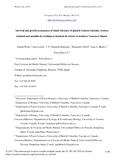Mostrar el registro sencillo del ítem
Survival and growth as measures of shade tolerance of planted western redcedar, western hemlock and amabilis fir seedlings in hemlock-fir forests of northern Vancouver Island
| dc.creator | Weber, Adrian | es_ES |
| dc.creator | Leckie, Sara | es_ES |
| dc.creator | Kimmins, J.P. (Hamish) | es_ES |
| dc.creator | Gilbert, Benjamin | es_ES |
| dc.creator | Blanco Vaca, Juan Antonio | es_ES |
| dc.creator | Lo, Yueh-Hsin | es_ES |
| dc.date.accessioned | 2016-12-19T15:13:14Z | |
| dc.date.available | 2019-02-15T00:00:10Z | |
| dc.date.issued | 2017 | |
| dc.identifier.issn | 0378-1127 | |
| dc.identifier.uri | https://hdl.handle.net/2454/23095 | |
| dc.description.abstract | We examined two measures of shade tolerance (survival and growth) of planted 1-year-old seedlings of western redcedar (Thuja plicata (Donn ex D. Don)), western hemlock (Tsuga heterophylla ([Raf.] Sarg.)) and amabilis fir (Abies amabilis ([Dougl. ex Loud] Dougl. ex Forbes)). Seedlings were planted at two different sites (forest interior: 4.5% mean above canopy photosynthetically active radiation [ACPAR], and forest edge: 41.5% mean ACPAR), in a 90-year-old, windthrow origin, unmanaged mesic western hemlock-amabilis fir stand. Seedlings were planted in 1997, and re-measured in 1998 and 2001 (after five growing seasons). To assess the effects of deer browsing on redcedar survival and growth, additional seedlings of this species were planted and protected with Vexar© tubes. To examine for nutrient-light interactions, half of these seedlings were fertilized with N-P-K and micronutrients at planting. Western redcedar had high levels of survival after 4 years (98% in edge plots and 93% in interior plots). Redcedar seedlings in edge plots were more vigorous but were browsed more heavily than in the interior plots. At edge sites, the negative effects of the Vexar© tubes may have been lower than their positive effects. Hemlock survival was about 50% in the stand interior but 80% in the edge plots. Amabilis fir in the interior plots had the lowest survival of the three species, with only 40% of initial seedlings surviving over the next four years, but had high survival in edge plots (95%). Height, biomass, and root collar diameter growth were significantly higher in edge plots for fir and hemlock. However, for redcedar, only biomass was significantly higher and no differences were detected for height and diameter. Our results show that shade tolerance cannot be assessed by simple measures of leaf/light relationships alone, but also requires consideration of light, nutrition, growth and browsing. | en |
| dc.format.mimetype | application/pdf | en |
| dc.language.iso | eng | en |
| dc.publisher | Elsevier | en |
| dc.relation.ispartof | Forest Ecology and Management 386 (2017) 13–21 | en |
| dc.rights | © 2016 Elsevier B.V. The manuscript version is made available under the CC BY-NC-ND 4.0 license. | en |
| dc.rights.uri | https://creativecommons.org/licenses/by-nc-nd/4.0/ | |
| dc.subject | Light tolerance | en |
| dc.subject | Light-nutrient interactions | en |
| dc.subject | Edge effects | en |
| dc.subject | Seedling survival | en |
| dc.subject | Seedling growth | en |
| dc.title | Survival and growth as measures of shade tolerance of planted western redcedar, western hemlock and amabilis fir seedlings in hemlock-fir forests of northern Vancouver Island | en |
| dc.type | Artículo / Artikulua | es |
| dc.type | info:eu-repo/semantics/article | en |
| dc.contributor.department | Ciencias del Medio Natural | es_ES |
| dc.contributor.department | Natura Ingurunearen Zientziak | eu |
| dc.rights.accessRights | Acceso abierto / Sarbide irekia | es |
| dc.rights.accessRights | info:eu-repo/semantics/openAccess | en |
| dc.embargo.terms | 2019-02-15 | |
| dc.identifier.doi | 10.1016/j.foreco.2016.11.019 | |
| dc.relation.publisherversion | https://dx.doi.org/10.1016/j.foreco.2016.11.019 | |
| dc.type.version | Versión aceptada / Onetsi den bertsioa | es |
| dc.type.version | info:eu-repo/semantics/acceptedVersion | en |



